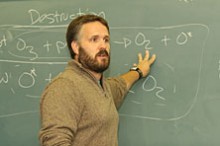Himalayan effort
The effort to constrain the link between global climate and determine how much of global warming has to do with natural geological processes will be furthered over the next couple of years by Assistant Professor of Chemistry and Geology Matthew Evans. The National Science Foundation (NSF) has awarded him a $109,880 grant to investigate Himalayan hot springs and their long-term effect on the global carbon cycle.
Evans plans to take at least one Wheaton College student with him to the Himalayas to help with research, which will be a collaborative effort between Wheaton and Cornell University. Undergraduate and graduate students from both schools also will do extensive laboratory work.
 The research continues and expands collaborative work he conducted with colleagues while working on his dissertation at Cornell University. Evans and colleagues sampled geothermal springs in Nepal and found that they produce large amounts of carbon dioxide CO2.
The research continues and expands collaborative work he conducted with colleagues while working on his dissertation at Cornell University. Evans and colleagues sampled geothermal springs in Nepal and found that they produce large amounts of carbon dioxide CO2.
Traditionally, it has been thought that the formation of mountains reduces atmospheric carbon dioxide, through a series of chemical reactions in which CO2 from the atmosphere combines with water to form a weak acid, which then breaks down minerals within these mountain belts, said Evans. However, his research of hot springs flowing on the southern flank of the Himalayan mountain range offers a different possibility.
"Our work has shown that the hot springs are bringing to the surface as much, if not more, CO2 than is being removed by these chemical weathering processes,” he said. "Up to this point, delivery of CO2 from mountain ranges hasn’t been considered a significant source. So this finding represents a significant shift in the current paradigm, and has impacts on our understanding of the relationship between tectonics, climate and the carbon cycle.”
The long-term climate record, said Evans, shows the extent of variability possible in the Earth system, from snowball to hothouse. "We need to understand how the carbon cycle and long-term global climate are related, even in the absence of humans, so that we can better estimate how the disturbances we are causing may impact the system.”
That understanding hinges on the ability to constrain the carbon sources and carbon "sinks” (places of accumulation). "Ultimately, Earth scientists are trying to figure out how the Earth works, and the linkage between mountain building, global climate and the carbon cycle is a great example of the dynamic Earth system.”
The carbon cycle, which plays a role in climate change, is the complex process in which CO2 is removed from and emitted back into the atmosphere, ideally in a balanced way. Since the Industrial Revolution, concentrations of CO2 in the atmosphere have greatly increased, largely due to human activities, according to the U.S. Environmental Protection Agency. Scientists, as well as policy makers, have been keenly interested in the long-term impact on life on Earth.
Evans’s NSF grant will provide two years of financial backing for research. Much of the funding will go to support fieldwork in central and western Nepal, and in northwestern India, a new area for him.
The students that he will take to the Himalayas will help with sampling. The funding also should support at least two student research projects or senior theses, he said. A summer salary for students to help perform chemical analyses, and collect and synthesize the chemical data is also available.
"It’s really a very exciting opportunity, both for me and for Wheaton,” said Evans, a geochemist who uses water chemistry to examine geological processes at and near the Earth’s surface.
 The research continues and expands collaborative work he conducted with colleagues while working on his dissertation at Cornell University. Evans and colleagues sampled geothermal springs in Nepal and found that they produce large amounts of carbon dioxide CO2.
The research continues and expands collaborative work he conducted with colleagues while working on his dissertation at Cornell University. Evans and colleagues sampled geothermal springs in Nepal and found that they produce large amounts of carbon dioxide CO2.